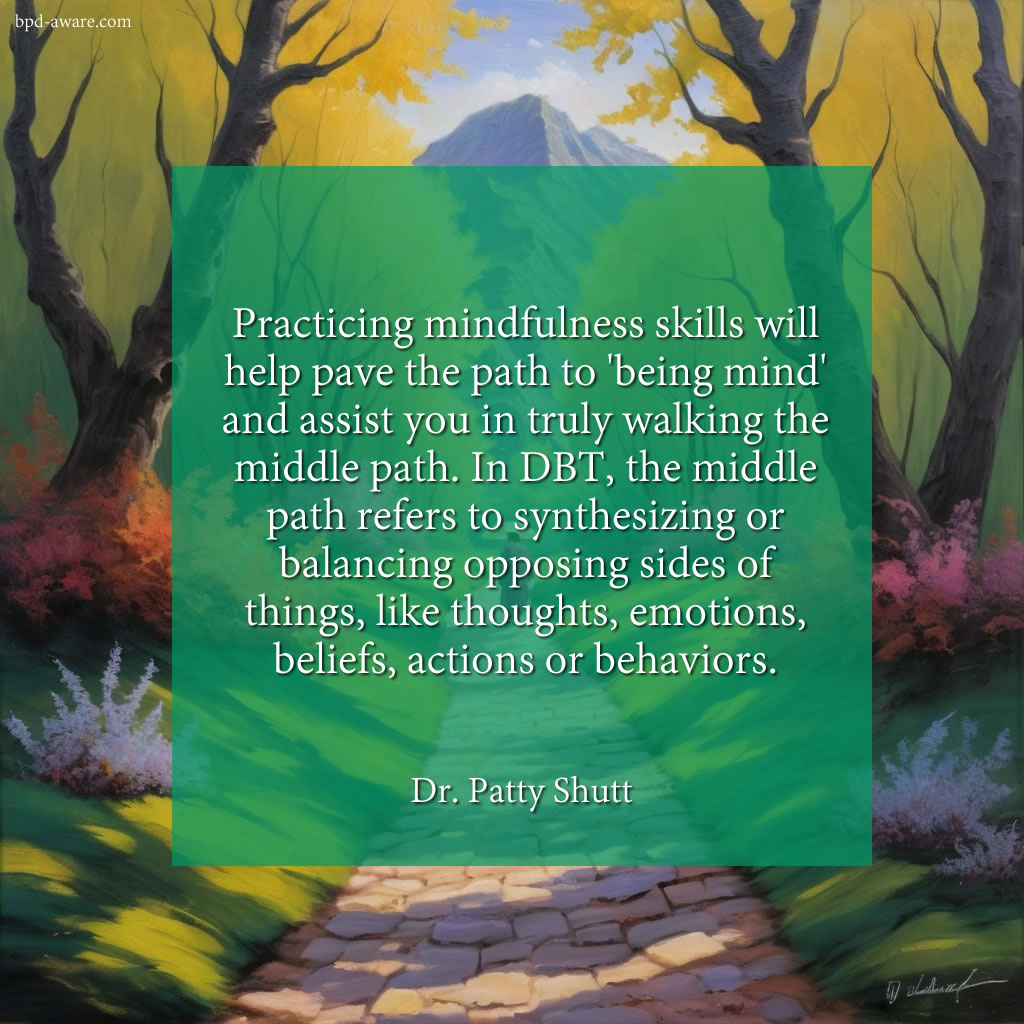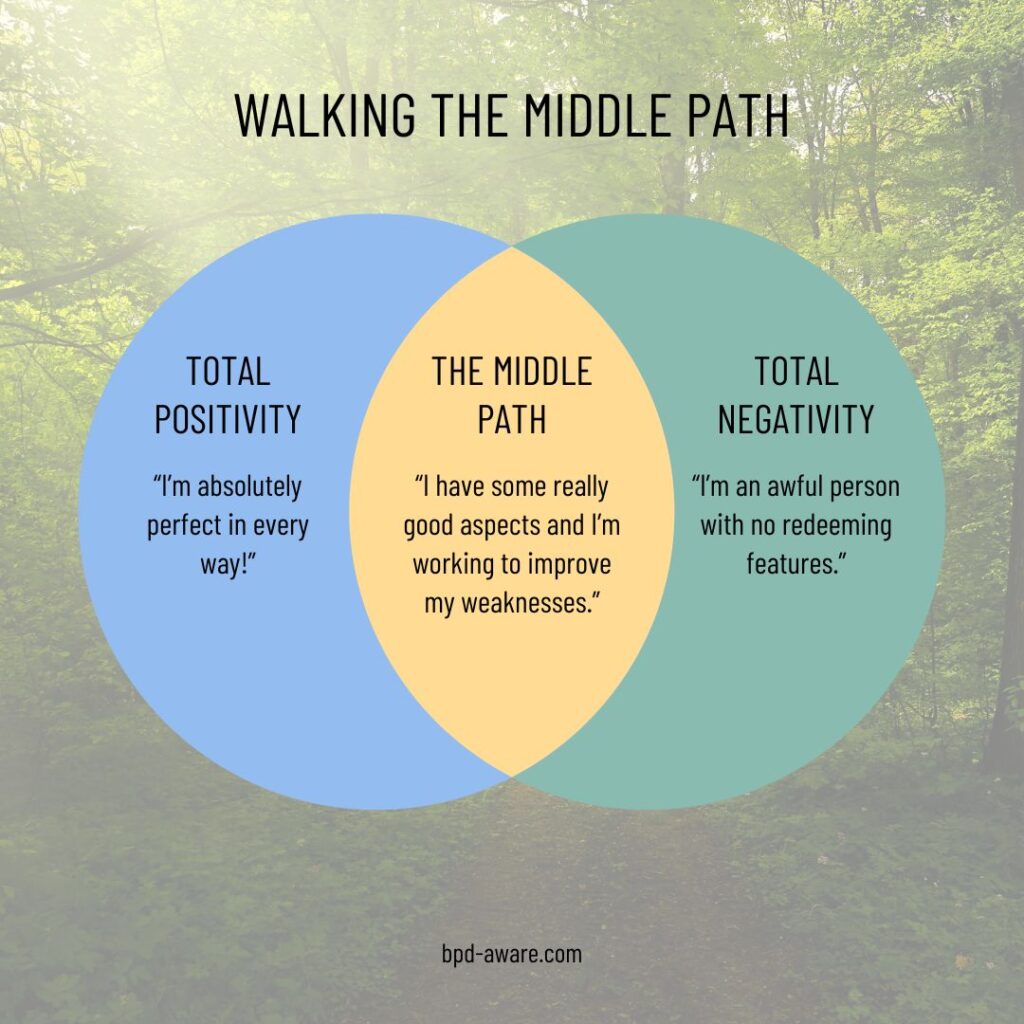Dialectical Behavior Therapy (DBT) is a form of Cognitive Behavioral Therapy (CBT) specifically designed to help people who struggle with emotional regulation, such as those with Borderline Personality Disorder (BPD). DBT focuses on teaching patients techniques to cope with distress, regulate emotions, and improve relationships with others.
One of the core features of BPD is black-and-white thinking (also known as also known as “all-or-nothing” or “dichotomous” thinking). It refers to the tendency to view situations, people, or oneself in extreme, absolute terms, rather than recognizing a spectrum of possibilities or a middle ground. This type of thinking doesn’t allow for grey areas or the complexity of most life situations. For example, if a person with BPD doesn’t receive a message back from their friend within a few minutes they might begin to believe their friend hates them or doesn’t value them – rather than that they might just be a bit busy or haven’t seen the message.
This type of thinking can create significant challenges for individuals with BPD, including unstable relationships, emotional turmoil, and difficulties in making balanced decisions. Part of the treatment, particularly in therapies like DBT, involves learning to recognize and challenge black-and-white thinking, developing a more nuanced perspective, and Walking the Middle Path in thoughts and reactions. This is crucial for improving emotional regulation, interpersonal relationships, and overall quality of life.
In this article, we will teach you more about the DBT skill of Walking the Middle Path, how it helps reduce black-and-white thinking, and how to begin practicing and developing the skills.
So What is Walking the Middle Path?
Within the spectrum of DBT skills, Walking the Middle Path plays a critical role. This skill is about finding a balance between two opposing sides, which is crucial for managing BPD. It involves recognizing and accepting the current situation or feelings while also understanding the need for change and working towards it.

The Importance of Walking the Middle Path
Walking the Middle Path is especially important in BPD treatment due to the tendency of individuals with BPD to think in extremes, often known as “black-and-white” thinking. This skill helps in navigating away from extreme thoughts and behaviors towards a more balanced and moderate approach. It aids in reducing conflicts, improving relationships, and managing emotions more effectively.
How To Begin Walking the Middle Path
Practicing “Walking the Middle Path” in the context of BPD involves learning to balance and integrate opposites, particularly the need for acceptance and the drive for change. This skill is a crucial component of DBT and can be particularly beneficial in managing the symptoms of BPD.
Here are some strategies for practicing this skill:
Understanding Dialectics: The first step is understanding the concept of dialectics, which is the idea that two opposite things can both be true. For example, you can accept yourself as you are while also recognizing the need for change and growth.

Avoiding Extremes in Thinking and Behavior: Recognize when you’re thinking in black-and-white terms and consciously try to find the middle ground. For instance, instead of categorizing things as perfect or terrible, try to see the nuances and gray areas. Instead of thinking, “I’m always wrong,” or “I’m perfect,” an individual might consider, “I make mistakes sometimes, and I also have successes.”
Balancing Acceptance and Change: Learn to identify what aspects of a situation or your behavior you can change and what you must accept. This involves acknowledging and tolerating uncomfortable emotions or realities (acceptance) while working to change what you can control (change).
Validation of Different Perspectives: In interpersonal interactions, try to understand and validate others’ perspectives, even if they differ from your own. This doesn’t mean agreeing with them but acknowledging that their views are valid for them. For example, you might disagree with a friend’s decision but can still understand their perspective. Remember, people come from a variety of backgrounds and have learned different things from their multitudes of life experiences.
Using “And” Instead of “But”: In your language, replace “but” with “and” to help integrate opposing viewpoints. For example, “I am doing my best, and I need to improve in some areas.”
Mindfulness Practices: Engage in mindfulness to stay present and avoid getting caught in extreme emotions or thoughts. Mindfulness helps in observing thoughts and feelings without judgment and finding a balanced perspective. This could be as simple as practicing a deep breathing exercise when feeling overwhelmed.
Seeking Feedback: Sometimes, it’s hard to see the middle path on your own. Try asking a trusted friend, family member, or therapist for their view on a situation that seems black and white to you. This can help you see perspectives you might have missed.
Reflecting on Past Experiences: Reflect on past situations where you might have reacted strongly. Consider how a more balanced approach could have changed the outcome, and think about how you can apply this learning to future situations.
Emotion Regulation Techniques: Use emotion regulation strategies to manage intense feelings that might lead to extreme thinking or behaviors. This could involve using coping skills like journaling or exercise when feeling emotionally overwhelmed.
Practicing Tolerance: Learn to tolerate distress without resorting to extreme thinking or behaviors. This includes recognizing that discomfort and pain are a part of life and developing coping strategies to deal with them effectively.
It’s important to note that Walking the Middle Path is a skill that takes time and practice to develop, much like any other skill. It can be challenging, especially in emotional situations, but with regular practice, it becomes natural to you and effective in managing the symptoms of BPD.
You may enjoy the video recorded by Rosie Cappucino about her experiences with Borderline Personality and how she began Walking the Middle Path.
Final Thoughts
Walking the Middle Path in DBT is a transformative skill for individuals with Borderline Personality Disorder. It fosters a balanced approach to thinking and responding, crucial for managing the symptoms of BPD. By embracing this skill, individuals can work towards a more stable and fulfilling life, characterized by healthier relationships and improved emotional regulation. As with all DBT skills, the journey of mastering Walking the Middle Path is gradual and requires patience and practice, but the path it lights leads to a more harmonious and balanced existence, one which greatly benefits those of us with BPD.
Sources, Resources, and Further Reading
- Walking The Middle Path: https://dbtselfhelp.com/walking-the-middle-path/
- Walking the Middle Path in DBT: Finding Balance in Life: https://www.grouporttherapy.com/blog/walking-the-middle-path-dbt
















